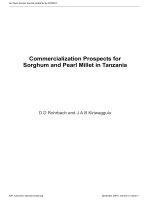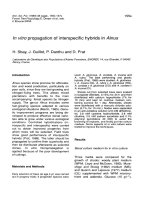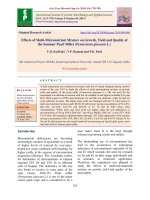Production of interspecific hybrids between pearl millet [Pennisetum glaucum (L.) R. Br.] × Napier Grass [Pennisetum purpureum (K.) Schum] and their characterization
Bạn đang xem bản rút gọn của tài liệu. Xem và tải ngay bản đầy đủ của tài liệu tại đây (303.71 KB, 6 trang )
Int.J.Curr.Microbiol.App.Sci (2019) 8(4): 1308-1313
International Journal of Current Microbiology and Applied Sciences
ISSN: 2319-7706 Volume 8 Number 04 (2019)
Journal homepage:
Original Research Article
/>
Production of Interspecific Hybrids between Pearl Millet [Pennisetum
glaucum (L.) R. Br.] × Napier Grass [Pennisetum purpureum (K.) Schum]
and their Characterization
Arshpreet Kaur1, Rahul Kapoor1*, Yogesh Vikal2, Anu Kalia3 and Ruchika Bhardwaj1
1
Department of Plant Breeding and Genetics, Punjab Agricultural University,
Ludhiana 141 004, India
2
School of Agriculture Biotechnology, Punjab Agricultural University,
Ludhiana 141 004, India
3
Nanotechnology and electron Microscopy Laboratory, Punjab Agricultural University,
Ludhiana 141 004, India
*Corresponding author
ABSTRACT
Keywords
Interspecific
hybrids,
Napier grass,
Hybridization,
pollen viability
Article Info
Accepted:
12 March 2019
Available Online:
10 April 2019
Interspecific hybrids between cultivars of pearl millet [Pennisetum glaucum (L.)
R. Br.] with 2n = 2x = 14 and its wild relative Napier Grass [Pennisetum
purpureum (K.) Schum] with 2n = 4x = 28, which have multicut behaviour,
perennial nature, high biomass and drought tolerance traits for crop improvement,
were obtained by cross hybridization. Twenty hybrid progenies were obtained and
then examined based on the morphological traits. Nine of them were confirmed to
be true interspecific hybrids. The confirmed interspecific hybrids were planted in
field and characterized on pollen fertility and cytogenetic basis along with two
check varieties. These interspecific hybrids were found to have low pollen
viability, probably due to abnormal meiosis.
Introduction
Sustainable strategies are needed to develop
biofuel systems that have high-energy
efficiencies, low food security trade-off risks
and significant environmental conservation
components. Due to their ability to efficiently
utilize water and nutrients, perennial grasses
such as Pearl millet-Napier grass hybrids
[Pennisetum glaucum (L.) R. Br. ×
Pennisetum purpureum (K.) Schum.] are
promising sources of germplasm that can be
grown for biomass production on more than
445 million hactares land worldwide
(Campbell et al., 2005).
Pearl millet [Pennisetum glaucum (L.) R. Br.]
has been also classified as Pennisetum
typhoideum, Pennisetum americanum or
Pennisetum spicatum and is locally known as
bajra in India. It ranks third after wheat
(Triticum aestivum) and rice (Oryza sativa)
1308
Int.J.Curr.Microbiol.App.Sci (2019) 8(4): 1308-1313
and among millets, pearl millet followed
sorghum (Pantulu and Rao 1982). It is the
basic staple food in the arid and semi-arid
regions of India. It is mostly used in poorest
countries and by the poorest people. So, also
known as the “Poor man’s cereal crop” (Alam
et al., 2010).
It is a kharif crop which grows in hot and dry
climates and it can be grown in areas where
there is deficiency of rainfall.
Pearl millet is often referred to as the “camel
crop” as it is a tropical plant and also because
of its ability to tolerate drought and. In India,
there is 8.68 million ha area under pearl millet
coupled with annual production of 8.61
million ha and has 999 kg/ha productivity.
It is a diploid, annual, allogamous species
with large chromosomes (2n = 2x = 14, AA)
coupled with 4.72 pg genomic DNA content.
Its bisexual flowers and protogynous habit of
flowering (stigmas exerted before anthers)
make it a plant which is readily self- or crosspollinated. It belongs to the primary gene pool
of genus Pennisetum and is well adapted to
poor and infertile soils. Its forage has better
nutritional quality in terms of crude protein
(%) and dry matter digestibility (%) along
with good palatability (Meena and Jain 2013).
Whereas
Napier
grass
(Pennisetum
purpureum Schumach.) is a perennial,
allogamous species commonly known as
elephant grass or Uganda grass. It has high
productive potential, carrying capacity,
nutrient quality and low water and nutrient
requirements that have highlighted it as the
chief tropical forages used for dairy grazing
system enhancement. It can make use of
otherwise uncultivated lands. It enhances the
soil fertility and act as safeguard against soil
erosion in arid areas. It can be employed for
firebreaks, windbreaks and most lately used in
the production of biogas, bio-oil and charcoal
(Pereira et al 2001, Mesa Perez et al., 2005,
Strezov et al., 2008).
Genetically it is tetraploid (2n = 4x = 28,
A'A'BB) species coupled with 4.60 pg
genomic DNA content (Martel et al., 1997)
and belongs to the secondary gene pool of this
genus. It is an important crop for diary
production in tropic area. In fact it is grown
due to its desirable traits such as drought
tolerance and wide adaptability to soil
conditions (Anderson et al., 2008).
It has high forage production potential
coupled with high biomass and is of multicut
nature that usually provides 5-8 cuts/year.
Furthermore, it has an excellent regeneration
potential along with its perennial growth
behaviour which makes it highly favourable
among the dairy farmers. It is also being used
as bio fuel (Perlack et al., 2006).
Pearl millet and napier grass hybridize to
produce perennial, vigorous, robust plants
(Burton 1944). They have the ability to
combine the perennial nature, high biomass,
winter hardiness, drought tolerance and
multicut behaviour of Napier grass with pearl
millet which is well adapted to drought and
has better nutritional quality coupled with
high palatability.
The hybrid is largely cultivated in the
subtropical regions of Asia, Southern Europe,
America and Africa whereas in India, the
major pearl millet Napier hybrid producing
states are Uttar Pradesh, Bihar, Madhya
Pradesh, Odisha, Gujarat, West Bengal,
Punjab, Haryana and Assam (Karforma
2018).
Materials and Methods
Ten inbred lines of pearl millet (female
parent) and ten lines of napier grass (pollen
parent) were taken as in Table 1.
1309
Int.J.Curr.Microbiol.App.Sci (2019) 8(4): 1308-1313
Crossing technique
Pearl millet is an allogamous crop and
production of seed is very easy due to its
protogynous nature. The inflorescence used as
a female (seed parent) or male parent (pollen
parent) was covered with the 30 × 10 cm
butter paper bag before any stigma became
visible. On the other side, fresh pollens from
dehiscing anthers visible as the yellow
powder were collected in the transparent
selfing bags by tapping. Then the pollination
was carried out by quickly removing the bag
from the female inflorescence, dusting the
pollens collected from the male inflorescence
with gentle tapping. Pollination was carried
out in morning hours between 8:00 A M to
11:30 A M. Then rebagging of the pollinated
inflorescence was done and labeled properly.
Characterization of interspecific hybrids
The F1 seed of each combination was
harvested at maturity and the F1 seed was
planted on raised nursery bed to remove the
bajra like plants. Nine pearl millet Napier
hybrids were then confirmed and planted in
field with two check varieties viz; PBN 233
and PBN 346. The row to row and plant to
plant spacing was 60 cm. All the
recommended cultural practices were
followed to raise the healthy crop.
Pollen staining (Sandhu et al., 2009)
Pollen grains were collected, after growing
them to maturity from the control and
colchicine treated plants. The time of pollen
collection was between 8:30 A M to 10:00 A
M when the anthers started to become
dehiscent and brushed over a clean glass
slide. Then a tiny drop of aceto-carmine was
put over the brushed pollen grains and a cover
slip was softly placed. The extra stain was
removed using blotting paper. Then the glass
slide was observed under compound
microscope with 40X magnification. Viable
(fully stained round pollen grains) and nonviable (shriveled unstained) pollen grains
were counted on three slides, at 10 different
locations per slide. The percentage of pollen
fertility was worked out by using the
following formula (Meena et al., 2017).
Pollenstaining(%)
No. of fertilepollens
100
No. of fertilepollens Sterile pollen
Cytogenetic study of interspecific hybrids
For cytogenetic studies, young flower buds
were collected and fixed in glacial acetic acid
and chloroform (1:1:1) for 24 hours. Freshly
prepared one percent acetocarmine stain was
used for staining chromosomes by usual
squash method. For different stages of
microsporogenesis, minimum of 10 well
spread and stained pollen mother cells were
observed.
Results and Discussion
As there were ten female parent and ten male
parent genotypes (Table 2) taken for the
study. Out of 100 possible interspecific
crosses, only 20 hybrids were produced which
contribute about 20% of total seed setting.
Then the twenty interspecific crosses were
sown in the raised nursery beds for the
confirmation of Pearl millet Napier hybrids.
At maturity, the plants were uprooted from
the field based on the inflorescence.
There were left only eleven interspecific
hybrids after characterization of hybrids
(uprooting of bajra like plants) (Table 2).
From the eleven interspecific hybrids, two
crosses that is PIB 962 × K 53802 and PIB
626 × K 5240 were having only one plant
after uprooting, so the morpho-agronomic and
quality traits data was recorded for only
remaining nine interspecific hybrids and two
1310
Int.J.Curr.Microbiol.App.Sci (2019) 8(4): 1308-1313
check varieties. The Table 2 represents the
number of inflorescences pollinated for all
hybrid genotypes and the approximate total
number of seeds which resulted from the
crosses.
Table.1 The list of genotypes used for present study
Sr No.
1.
2.
3.
4.
5.
6.
7.
8.
9.
10.
Female Parent
Giant Bajra
RBC 2
FBC 16
PIB 394
PIB 885
PIB 962
PIB 626
PIB 339
PCB 164
PIB 932
Sr No.
1.
2.
3.
4.
5.
6.
7.
8.
9.
10.
Male Parent
M 30086
TAIWAN
K 52440
K 59347
K 5240
K 53802
K 52504
Capricon
T 13
MERKER
Table.2 Results of field pollinations in interspecific crosses involving Pennisetum species
Sr
No.
Parents
1
2
3
4
6
7
8
9
11
12
13
14
15
16
17
19
20
Giant Bajra × TAIWAN
FBC 16 × M 30086
FBC 16 × K 52440
PIB 394 × M 30086
PIB 394 × K 52440
PIB 394 × K 5240
PIB 885 × TAIWAN
PIB 885 × K 53802
PIB 962 × TAIWAN
PIB 962 × K 53802
PIB 626 × M 30086
PIB 626 × K 52504
PIB 626 × K 5240
PIB 339 × TAIWAN
PIB 339 × K 59347
PCB 164 × K 5240
PIB 932 × TAIWAN
Total
number of
plants
25
18
10
22
25
3
42
27
5
1
23
49
9
18
10
36
5
1311
Number of
plants uprooted
PMN Hybrids
25
0
3
4
7
3
42
27
0
0
23
45
8
9
0
32
5
0
18
7
18
18
0
0
0
5
1
0
4
1
9
10
4
0
Int.J.Curr.Microbiol.App.Sci (2019) 8(4): 1308-1313
Fig.1 Showing pollen viability of parents (A) Pennisetum glaucum (B) P. purpureum (C)
Interspecific hybrid
(C
)
(B
)
(A
)
Fig.2 Cytological investigation showing (A) metaphase of Pennisetum glaucum (2n = 2x = 14),
(B) Anaphase of Pennisetum glaucum (2n = 2x = 14), (C) pairing of chromosomes at meiosis1 of
PMN Hybrid, (D) bivalents of PMN Hybrid, (E) synapsis of PMN Hybrid, (F) univalents of
PMN Hybrid, (G) metaphase of PMN Hybrid, (H) univalents of PMN Hybrid
(A
)
(B
)
(C
)
(D)
(E
)
(F
)
(G)
(H)
Pollen viability in interspecific hybrids
Cytogenetic study
The pollen viability of parental lines
Pennisetum glaucum and P. purpureum was
almost 100% as revealed by dark staining of
round, uniform and normal sized pollens. On
the other hand, the pollen viability of
interspecific hybrids was found almost zero
per cent showed the abnormal and light or no
stained pollens as shown in Figure 1.
The slides were prepared using inflorescence
from the confirmed interspecific hybrids. And
they found 2n = 3x = 21 chromosomes in an
interspecific hybrid as shown in Figure 2.
References
Alam, A., Faridullah, I. M., Khan, J., Khan, A. R.,
Sher, H. and Khan, K., 2010.
1312
Int.J.Curr.Microbiol.App.Sci (2019) 8(4): 1308-1313
Comparative studies of different pearl
millet varieties as affected by different
yield components. Electronic. J. Environ.
Agric. Food. Chem. 9, 1524-1533.
Anderson, W. F., Dien, B. S., Brandon, S. K., and
Peterson, J. D., 2008. Assessment of
Bermuda grass and bunch grasses as feed
stocks for conversion to ethanol. App.
Biochem. And. Biotech. 145, 13-21.
Burton, G. W., 1944. Hybrids between Napier
grass and cattail millet. J. Hered. 35, 227232.
Campbell, S. G., Hoyle, N. P., and Ashe, M. P.,
2005. Dynamic cycling of Eif2 through a
large eIF2B-containing cytoplasmic body:
implications for translation control. J.
Cell. Biol. 170, 925-934.
Karforma, J., 2018. Hybrid Napier (napier bajra
hybrid). Forage. Crops. Of. World. 1,
159-170.
Martel, E., De, Nay. D., Siljak-Yakovlev, S., and
Brown, S., (1997) Genome size variation
and basic chromosome number in pearl
millet and fourteen related Pennisetum
species. J. Hered. 88, 139-143.
Meena, H. P., Sujatha, M., and Kumar, P. S.,
2017. Interspecific hybrid between
cultivated sunflower (Helianthus annuus)
and silver leaf sunflower H. argophyllus
T. & G.: Cytomorphological and
molecular characterization. Indian. J.
Genet. 77(4), 547-555.
Meena, S. N., and Jain, K. K., 2013. Effect of
varieties and nitrogen fertilization on
fodder pearl millet (Pennisetum glaucum)
in north western Rajasthan. Indian. J.
Agron. 58(2), 262-263.
Mesa-Perez, J. M., Cortez, L. A. B., Rocha, J. D.,
Brossard-Perez, L. E. and OlivaresGomez, E. 2005. Unidimensional heat
transfer analysis of elephant grass and
sugarcane bagasse slow pyrolysis in a
fixed bed reactor. Fuel. Process. Technol.
86, 565-575.
Pereira, L. M. L., Berchielli, T. T., Nogueira, J.
R., Ruggieri, A. C., Magalhaes, A. L. J.,
Dias, S. A. K., Guimaraes, S. J. P. 2001.
Estimation of voluntary intake of tanzania
grass (Panicum maximum) jacq cv.
Tanzania) rotationally grazed by lactating
cows. Rev. Bras. Zootec. 30(6), 19191924.
Perlack, R. D., Wright, L. L., Turhollow, A. F.,
Graham, R. L., Stokes, B. J., and Erbach,
B. C. 2006. Biomass as a feedstock for a
bioenergy and bioproducts industry: The
technical feasibility of a billion-ton
annual supply. DOE. ORNL. Oak Ridge,
Tamil Nadu.
Pantulu, J. V., and Rao, M. K., 1982.
Cytogenetics of pearl millet. Theor. Appl.
Genet. 61, 1-17.
Sandhu, S., James, V. A., Quesenberry, K. H., and
Altpeter. F., 2009. Risk assessment of
transgenic
apomictic
tetraploid
bahiagrass,
cytogenetics,
breeding
behaviour and performance of intraspecific hybrids. Theor. Appl. Genet. 119,
1383-1395.
Strezov, V., Evans, T. J., and Hayman. C., 2008.
Thermal conversion of elephant grass
(Pennisetum purpureum Schum) to biogas, bio-oil and charcoal. Biores. Tech.
99, 8394-8399.
How to cite this article:
Arshpreet Kaur, Rahul Kapoor, Yogesh Vikal, Anu Kalia and Ruchika Bhardwaj. 2019.
Production of Interspecific Hybrids between Pearl Millet [Pennisetum glaucum (L.) R. Br.] ×
Napier Grass [Pennisetum purpureum (K.) Schum] and their Characterization.
Int.J.Curr.Microbiol.App.Sci. 8(04): 1308-1313. doi: />
1313







![Genetic analysis for micronutrients and grain yield in relation to diverse sources of cytoplasm in pearl millet [Pennisetum glaucum (L.) R. Br.]](https://media.store123doc.com/images/document/2020_01/13/medium_ion1578932058.jpg)

